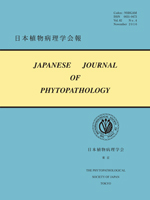
- Issue 4 Pages 215-
- Issue 3 Pages 109-
- Issue 2 Pages 67-
- Issue 1 Pages 1-
- |<
- <
- 1
- >
- >|
-
K. ISHIKAWA, T. KURODA, D. IWATA2023 Volume 89 Issue 2 Pages 67-76
Published: May 25, 2023
Released on J-STAGE: June 10, 2023
JOURNAL FREE ACCESSIn Japan, rice multilines (MLs) for blast control are derived from randomly mixed seeds of isogenic lines (ILs) and are transplanted 4–6 plants per hill in paddy fields. Consequently, the composition of the ILs is stochastically determined and not uniform among the hills. Also, the disease progression in the respective hills varies due to the proportion of susceptible ILs to total plants and to the spatial configuration within the hills. We tested our hypothesis that these factors can influence temporal changes in the local composition of blast races using a lattice model, which showed that the non-uniform compositions and heterogeneous spatial configuration of the ILS in hills could result in a faster increase of disease severity compared with a uniform composition and homogeneous configuration and that the tendency will be more obvious when the proportion of susceptible lines is smaller. These results also suggest that in these conditions, the frequencies of virulent races where more ILs are present among the MLs will increase slower than expected compared with a uniform composition and homogeneous configuration of ILs.
View full abstractDownload PDF (665K)
-
A. KAWAKAMI, M. TAKATA, N. KIRINO, H. KANETANI, T. TODA2023 Volume 89 Issue 2 Pages 77-80
Published: May 25, 2023
Released on J-STAGE: June 10, 2023
JOURNAL FREE ACCESSWeb blight of peach (Prunus persica L.) was found in Akaiwa, Okayama, Japan in August 2019. The pathogen isolated from infected leaves and branches was identified as Rhizoctonia solani AG-1 IB based on hyphal anastomosis, cultural characteristics and the rDNA internal transcribed spacer sequence. This is the first report of web blight of peach caused by R. solani in Japan, and we propose the Japanese name “kumonosu-byo” for the disease.
View full abstractDownload PDF (6573K) -
S. YOKOSAWA2023 Volume 89 Issue 2 Pages 81-84
Published: May 25, 2023
Released on J-STAGE: June 10, 2023
JOURNAL FREE ACCESSIn 2016, brown spots were found on walnut (Juglans regia L.) leaves and fruits in Nagano Prefecture, Japan. A white to gray fungus was isolated from the brown spot lesions and identified as Ophiognomonia leptostyla (Fr.) Sogonov based on morphological characteristics and rDNA LSU, rDNA ITS and EF-1α sequences. Inoculation of walnut leaves with O. leptostyla caused the same brown spots on the leaves, and the fungus was reisolated from the lesions. This is the first report of walnut brown spot (anthracnose) caused by O. leptostyla in Japan.
View full abstractDownload PDF (623K)
- |<
- <
- 1
- >
- >|